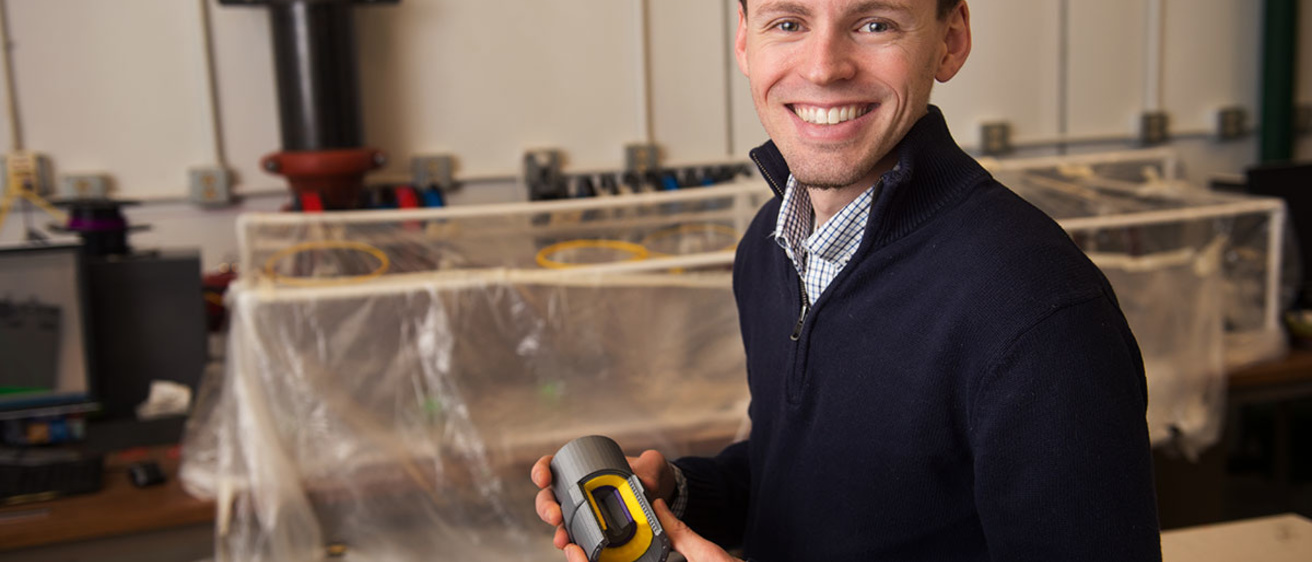So, what do you do here?
Oh…that’s complicated. I’ve been a member of the High Energy Physics (HEP) group at the UI since 2003, where I began as a high school student working through a program called Quarknet. After getting my B.S. in physics, a certificate in Entrepreneurial Management, and a Ph.D. in physics—all from the UI—I continue to work for the HEP group on an hourly basis, mentoring undergraduate and graduate students about life and the steep learning curve required to be a part of the Compact Muon Solenoid (CMS) experiment, and continuing to analyze data and building world-class detector infrastructure. I also like to keep involved with the Van Allen Observatories—check out twitter.com/clearskypatrol for more information!
The rundown
Department: Physics and Astronomy
Job: Research Affiliated Scholar
Years at UI: 12
Family: I live with my girlfriend, Shelly, and my cat, Leonard.
Hometown: Bettendorf, Iowa
Alma maters: Bettendorf High School; the University of Iowa
How did you become interested in physics and why?
I have always been drawn to big projects and have always wanted to contribute to something in a big way. When Pete Bruecken, my physics teacher at Bettendorf High School, asked me if I wanted to drive from Bettendorf to Iowa City every day to work on projects for the Compact Muon Solenoid (which was still five years away from being completed), I said for sure!
At the time, I was a pretty serious musician and was considering a career in music. I really wanted to attend Berklee College of Music. However, after working with Professor Yasar Onel at Iowa (who said, "if you come to Iowa, you will have a job here"), and the positive, supportive environment he had built and the cool people who worked there, along with the glamorous billing of the "most complicated scientific experiment ever attempted by human kind," I decided to enroll at Iowa. Of course, that meant studying physics, which turned out to be a lot of fun, though it was definitely intimidating at times.
Take us through how you got involved in printing a 3–D replica of the world’s most advanced particle detector.
I have a really annoying artistic bone constantly nagging me to create. When these 3–D printers came along, I kept thinking it would be useful to have one. Fermi National Accelerator Laboratory (the U.S. home base for the CMS experiment) has $6,000 grants for outreach related to the CMS experiment. I applied, saying I would design and print a 3–D model of the CMS experiment. Don Lincoln, the reviewer, gave me the grant, on the condition that I designed something that could be mass-produced. Now, that was a challenge. So I delivered one. People loved it. So Don said, "All right, let’s go for 70." And so many people want one that the order has gone up to 100.
What’s the biggest risk you’ve ever taken—and did it pay off?
I take risks all the time, and they always pay off, and I encourage people to do so—just be thoughtful about it. It’s funny, because I’m normally very anxious, but I do many potentially dangerous things, like rock climb, crawl around radioactive detectors, and fly to Europe and get inside tiny elevators that go 30 stories underground. The trick is to be thoughtful, obsess over the details, and then execute.
The biggest I-might-die risk I’ve ever taken was probably flying to Arizona with my friend Todd, hiking three miles into the Arizona desert to a 120-foot tall rock totem pole, just the two of us, and then climbing it. That was an adventure. Totally worth it. I never felt afraid because we were prepared.
If you could spend a day with anyone, from any era, who would it be and why?
Oh gosh, just one…hmm…right now I would really like to talk with Frédéric Chopin, because I’m (attempting) to learn his Polonaise in A flat Major. But if I could change the question a bit, I would be most interested in attending the Fifth Solvay International Conference on Electrons and Photons, held in 1927. In attendance: Einstein, Heisenberg, Pauli, Schrödinger, Lorentz, Curie, Bohr…all in one room! Can you imagine?!
If you could get rid of one invention in the world, what would you choose? Why?
Blister product packing.
Name five of your favorite things.
- The Harvest Preserve, in northeast Iowa City
- The Jimi Hendrix Experience
- Jackson Pollock
- Apple, Inc.
- Life
